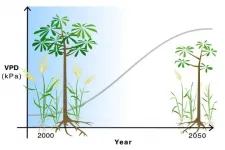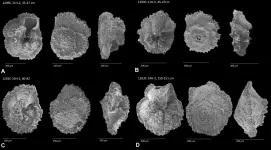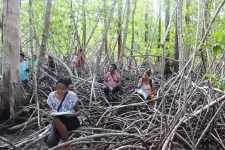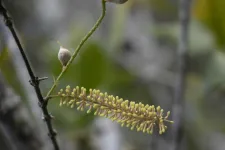Study highlights barriers for women and marginalized groups in supramolecular chemistry
2021-03-08
(Press-News.org) A new study by the international network Women In Supramolecular Chemistry (WISC) has highlighted the equality, diversity and inclusion (EDI) issues faced by women and marginalised groups working within that field.
The network has also set out a 'calling in' approach to address these issues.
The study, led by Dr Jennifer Leigh and Dr Jennifer Hiscock (both University of Kent) alongside WISC's wider team of international researchers, found that both men and women in the supramolecular community wanted to see more mentoring opportunities and more visibility for women and marginalised groups. There is a desire for more guidance during the transition from postdoctoral researcher to independent Principal Investigator, to ensure women can be retained and progress in supramolecular chemistry.
Furthermore, it was established that there is the need for a space to share concerns around career breaks, parenting, and the demands of balancing work with other aspects of life. Shared lived experiences documented in the survey showed differences in experiences between men and women taking career breaks or parental leave, with women reporting obstacles in progression and increased pressures upon return. The men surveyed did not note problems upon return.
WISC is following up on the study with a mentoring scheme to actively support the needs of the supramolecular chemistry community and will continue its approach to 'call in' colleagues to act together to address EDI issues. 'Calling in' is the gentler act of alerting peers to their behaviour with compassion and guidance, as opposed to 'calling out' which usually refers to publicly pointing out oppressive behaviour. A second survey exploring experiences through Covid-19 (open to the supramolecular community) is currently underway as ongoing research continues.
It is well documented that women in science, technology, engineering, and mathematics (STEM) academia are disproportionately affected by funding structures, academic culture, research environments and caring responsibilities, which has been further implicated by the Covid-19 pandemic. Culture and other factors such as disability, ethnicity and race, are also noted by the study team as marginalising barriers. WISC, which was formed in 2019 as an area specific international community, hopes to bring change to the EDI issues experienced in supramolecular chemistry through its network.
While the study was carried out specifically in the supramolecular chemistry community, the team hope that new EDI approaches could be adopted in other fields. Dr Leigh said: 'Our strategy of calling in and rigorous social science research is not field-specific. By sharing our approach and results, we hope that our work may act as a framework to those within other fields and disciplines who are keen to tackle EDI issues.'
Dr Hiscock said: 'WISC is only at the beginning of its work. When we launched the network, we were cautious of projecting our own experiences and assumptions onto others, therefore bringing a social science approach into our research ensured rigour, validity and ethics. 'Calling in' invites individuals to discuss something that might be uncomfortable in a safe environment without the fear of getting it wrong, and then pulls together the community as a whole to make positive changes. We look forward to continuing to bring change in the community.'
INFORMATION:
Their research paper 'An area specific, international community-led approach to understanding and addressing EDI issues within supramolecular chemistry' (Dr Jennifer S. Leigh, University of Kent; Dr Jennifer R. Hiscock, University of Kent; Dr Claudia Caltagirone, University of Cagliari; Dr Emily R. Draper, University of Glasgow; Professor Michaele J. Hardie, University of Leeds; Dr Cally J. E. Haynes, University College London; Professor Katrina A. Jolliffe, University of Sydney; Dr Marion Kieffer, University of Bristol; Dr Anna J. McConnell, Christian-Albrechts-Universität zu Kiel, Germany) is published by Angewandte Chemie.
https://www.onlinelibrary.wiley.com/doi/10.1002/anie.202015297
DOI: 10.1002/anie.202015297
About Women In Supramolecular Chemistry (WISC)
Women In Supramolecular Chemistry (WISC) is led by an international team of women from early-to-mid career levels, with an advisory board comprising diverse and senior researchers in the field. As a cohort we represent researchers from four continents, different ethnic backgrounds, and include members with disabilities/chronic illnesses/neurodivergencies.
WISC was formed when its founders (Jennifer Hiscock - University of Kent, Cally Haynes - University College London, Claudia Caltagirone - University of Cagliari and Anna McConnell - University of Kiel) realised that they needed more support and organised themselves to have bi-monthly online meetings to talk about their research, publications, grant proposals and to generally connect. They found support from senior women within supramolecular chemistry (Professors Kate Jolliffe - University of Sydney and Michaele Hardie - Leeds University), and quickly realised they had formed themselves into an informal mentoring cluster, with a group of peers. They all saw the value of this model and were encouraged by Jolliffe and Hardie to expand the idea and turn the network into something that could benefit the supramolecular community as a whole.
For further information or interview requests, please contact Sam Wood at the University of Kent Press Office.
Tel: 07713087981
Email: s.wood-700@kent.ac.uk
News releases can also be found at
http://www.kent.ac.uk/news
University of Kent on Twitter: http://twitter.com/UniKent
Notes to Editors
The University of Kent is a leading UK university producing world-class research, rated internationally excellent and leading the way in many fields of study. Our 20,000 students are based at campuses and centres in Canterbury, Medway, Brussels and Paris.
With 97% of our research judged to be of international quality in the most recent Research Assessment Framework (REF2014), our students study with some of the most influential thinkers in the world. Universities UK recently named research from the University as one of the UK's 100 Best Breakthroughs of the last century for its significant impact on people's everyday lives.
We are renowned for our inspirational teaching. Awarded a gold rating, the highest, in the UK Government's Teaching Excellence Framework (TEF), we were presented with the Outstanding Support for Students award at the 2018 Times Higher Education (THE) Awards for the second year running.
Our graduates are equipped for a successful future allowing them to compete effectively in the global job market. More than 95% of graduates find a job or study opportunity within six months.
The University is a truly international community with over 40% of our academics coming from outside the UK and our students representing over 150 nationalities.
We are a major economic force in south east England, supporting innovation and enterprise. We are worth £0.9 billion to the economy of the south east and support more than 9,400 jobs in the region.
In March 2018, the Government and Health Education England (HEE) announced that the joint bid by the University of Kent and Canterbury Christ Church University for funded places to establish a medical school has been successful. The first intake of undergraduates to the Kent and Medway Medical School will be in September 2020.
We are proud to be part of Canterbury, Medway and the county of Kent and, through collaboration with partners, work to ensure our global ambitions have a positive impact on the region's academic, cultural, social and economic landscape.
ELSE PRESS RELEASES FROM THIS DATE:
2021-03-08
(COLUMBUS, Ohio) - Concussion, a form of traumatic brain injury, is a common injury among children and teens. Concussions can have adverse effects on physical, cognitive, emotional and sleep health. Clinical guidelines for managing concussion in children and teens traditionally recommend complete physical and cognitive rest until symptom resolution, followed by a gradual return to activities like school and sports. These guidelines are often disputed and based on expert consensus as opposed to strong evidence. The challenge has been how to quantify the amount of physical and cognitive activity that children and teens should engage in during recovery. A new study by researchers at the Center for ...
2021-03-08
While cigarette smoking continues to be the leading cause of preventable disease, disability and death in the U.S., the evidence base for cessation support has revealed that telephone call centers, or "quitlines," have been a particularly successful intervention, according to the Centers for Disease Control and Prevention (CDC), which recently published a compilation of scientific research in the American Journal of Preventive Medicine.
Titled "The Role of Quitlines in Tobacco Cessation," the supplement is composed of nine peer-reviewed articles and three commentaries presenting the latest science on quitlines' effectiveness for smoking termination. The compilation demonstrates the relevance and importance of call ...
2021-03-08
A global observation of an ongoing atmospheric drying -- known by scientists as a rise in vapor pressure deficit -- has been observed worldwide since the early 2000s. In recent years, this concerning phenomenon has been on the rise, and is predicted to amplify even more in the coming decades as climate change intensifies.
In a new paper published in the journal Global Change Biology, research from the University of Minnesota and Western University in Ontario, Canada, outlines global atmospheric drying significantly reduces productivity of both crops and non-crop plants, even under well-watered conditions. The new findings were established on a large-scale analysis covering 50 years of research and 112 plant species.
"When there ...
2021-03-08
Lockdown and other restrictions imposed to control the COVID-19 pandemic have had unseen negative effects on the cognitive capacity and mental health of the population. A study led by the UOC's research group Open Evidence, in collaboration with international universities and BDI Schlseinger Group Market Research, has gauged the impact of the measures taken during the first and second waves of the virus on citizens of three European Union countries. The study concludes that the shock produced by the situation has reduced people's cognitive capacity, leading them to take more risks, ...
2021-03-08
Astronomers have discovered new hints of a giant, scorching-hot planet orbiting Vega, one of the brightest stars in the night sky.
The research, published this month in The Astrophysical Journal, was led by University of Colorado Boulder student Spencer Hurt, an undergraduate in the Department of Astrophysical and Planetary Sciences.
It focuses on an iconic and relatively young star, Vega, which is part of the constellation Lyra and has a mass twice that of our own sun. This celestial body sits just 25 light-years, or about 150 trillion miles, from Earth--pretty close, astronomically speaking.
Scientists can also see Vega with telescopes even when it's light out, which makes ...
2021-03-08
Microscopic fossilized shells are helping geologists reconstruct Earth's climate during the Paleocene-Eocene Thermal Maximum (PETM), a period of abrupt global warming and ocean acidification that occurred 56 million years ago. Clues from these ancient shells can help scientists better predict future warming and ocean acidification driven by human-caused carbon dioxide emissions.
Led by Northwestern University, the researchers analyzed shells from foraminifera, an ocean-dwelling unicellular organism with an external shell made of calcium carbonate. After analyzing the calcium isotope composition of the fossils, the researchers concluded that massive volcanic activity injected large amounts of carbon dioxide into the Earth system, causing global warming and ocean acidification.
They ...
2021-03-08
Artificial intelligence can already scan images of the eye to assess patients for diabetic retinopathy, a leading cause of vision loss, and to find evidence of strokes on brain CT scans. But what does the future hold for this emerging technology? How will it change how doctors diagnose disease, and how will it improve the care patients receive?
A team of doctors led by UVA Health's James H. Harrison Jr., MD, PhD, has given us a glimpse of tomorrow in a new article on the current state and future use of artificial intelligence (AI) in the field of pathology. Harrison and other members of the College of American Pathologists' Machine Learning ...
2021-03-08
In a new paper published in Light: Science & Applications, the group led by Professor Andrea Fratalocchi from Primalight Laboratory of the Computer, Electrical and Mathematical Sciences and Engineering (CEMSE) Division, King Abdullah University of Science and Technology (KAUST), Saudi Arabia, introduced a new patented, scalable flat-optics technology manufactured with inexpensive semiconductors.
The KAUST-designed technology leverages on a previously unrecognized aspect of optical nanoresonators, which are demonstrated to possess a physical layer that is completely equivalent to a feed-forward deep neural network.
"What we have achieved," explains Fratalocchi, "is a technological process to cover ...
2021-03-08
Women are largely being excluded from decisions about conservation and natural resources, with potentially detrimental effects on conservation efforts globally, according to research.
A University of Queensland and Nature Conservancy study reviewed a swathe of published conservation science, investigating the cause and impact of gender imbalance in the field.
UQ PhD candidate and Nature Conservancy Director of Conservation in Melanesia Robyn James said it was no secret that females were underrepresented in conservation science.
"In fact, according to a recent analysis of 1051 individual top?publishing authors in ecology, evolution and conservation research, only 11 per cent were women," Ms James said.
"We analysed more than 230 peer-reviewed articles attempting ...
2021-03-08
One of the world's rarest tree species has been transformed into a sophisticated model that University of Queensland researchers say is the future of plant research.
"Macadamia jansenii is a critically endangered species of macadamia which was only described as a new species in 1991," said Robert Henry, Professor of Innovation at the Queensland Alliance for Agriculture and Food Innovation (QAAFI).
"It grows near Miriam Vale in Queensland and there are only around 100 known trees in existence."
However, with funding from Hort Innovation's Tree Genomics project, and UQ's Genome Innovation Hub Macadamia jansenii has now become the world's most sophisticated plant research model.
Professor Henry said ...
LAST 30 PRESS RELEASES:
[Press-News.org] Study highlights barriers for women and marginalized groups in supramolecular chemistry




